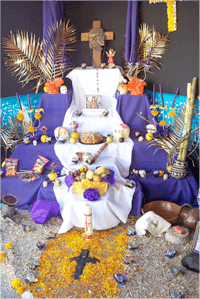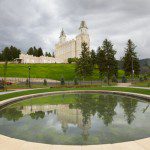 |
| Photo Courtesy of Christian Frausto Bernal Creative Commons License, Flickr |
In the heart of every Catholic Church you enter you will find the altar, the place where we celebrate Holy Communion and break bread and drink wine together. It is where we experience God breaking into the community each week. Often around the church you will also find other small altars. Perhaps there is one in front of a statue of Mary where people have left a rosary or holy card or some other offering. Another might be an altar for the dead erected for the month of November; here the community adds photos of loved ones who have died. Altars are found across traditions and cultures and essentially are places where the intentions and prayers of a person or community become concentrated. The space becomes what the Celtic peoples called a "thin place," where the boundary between heaven and earth feels especially permeable. It is at the altars we create where we meet the One who created us.
I have an altar space in my prayer corner in our living room. It is set on top of a beautiful old secretary desk that comes from my father's family and so in the last century and a half has traveled from Riga, Latvia to Vienna to New York to Sacramento to San Francisco to Berkeley to Seattle. I love the history it has and the connection to my paternal ancestors.
Inside the desk I keep my journal and books I am reading. Across the top I keep objects of significance to me that rest more permanently, like a photo of my mother who died six years ago, a carved wooden statue of Our Lady of Guadalupe, a glass cross given to me by a friend, and a candle holder.
Then there are the more temporary objects gracing this altar space, which usually reflect the season we are in, both liturgical and natural. I bring in a purple cloth for Advent or some fallen leaves for autumn, a small vase of spring flowers or a basket of hand-painted wooden eggs for Easter. Often there is a piece of art I am pondering or an icon. There is a tension here between those things that feel more permanent and enduring and those that are more fleeting, representative of our pilgrimage through time and its changing qualities.
When it is time for a new season I clear off several of these sacred items, laying them ever so carefully in a drawer, and thanking them for their wisdom and guidance so far. Then I leave space to listen for what new symbols want to dwell there and help reveal to me this next layer God is inviting me to tend. Inevitably I will discover what needs to be added. Sometimes it is a stone whose shape speaks to me of the deeper groundedness I am seeking in my life. Often it is a new image that moves something in me I can't yet name. As I place new objects that feel holy, the sacredness of my own story unfolds slowly.
Altars can be very powerful. In creating altars, we fill a personal space with the power of our own prayers, intentions, and longings. We take seriously those deep desires of our hearts that St. Ignatius of Loyola wisely said were planted there by God in the first place. We acknowledge an incarnational God who speaks through symbols and pulses through the things of our everyday lives, imbuing them with meaning. We express our faith that our prayers matter.
A personal altar is a sacred space where we can re-center and reconnect with the holy presence dwelling in our midst. It is a place to honor the desires of our lives with beauty. Altars help to give voice to the longings stirring up within us long before we can put them into words. It is an act of trust to listen to those symbols that want a place in our lives. It is a reminder that there is a greater wisdom, bigger than our daily worries and concerns.
Is there a space in your home you might devote as a tangible reminder of the presence of God? What are the symbols you would like include? What longings and prayers need symbolic expression in your life right now?
Christine Valters Paintner, Ph.D. is a Benedictine Oblate and the founder and director of Abbey of the Arts, a non-profit ministry integrating contemplative practice with the expressive arts. She teaches at Seattle University's School of Theology and Ministry and also works as a spiritual director, retreat facilitator, writer, and artist. She is the co-author of Lectio Divina: Contemplative Awakening and Awareness from Paulist Press. Visit her website Abbey of the Arts.
7/10/2009 4:00:00 AM





